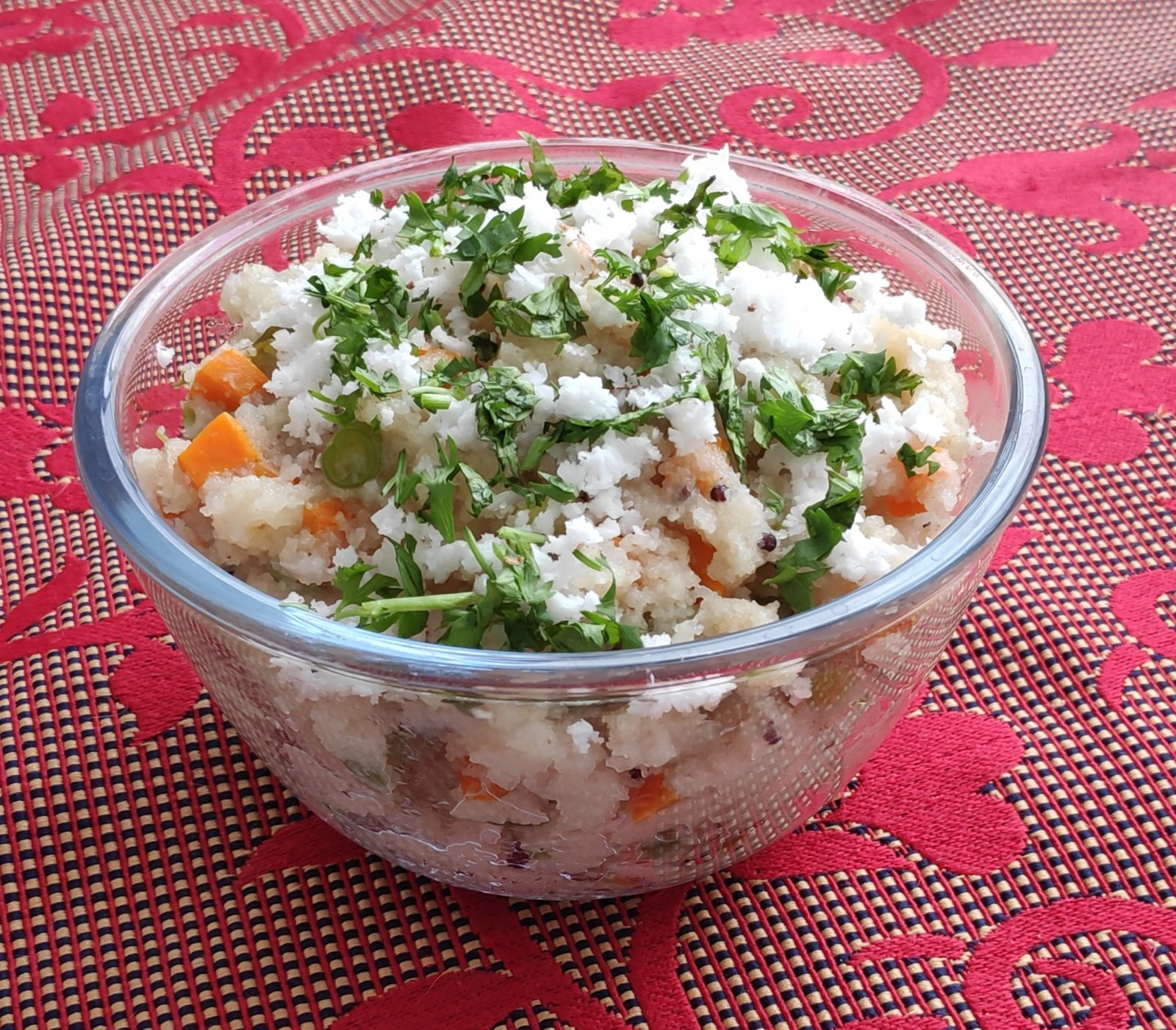Recipe credit: Darshana Muzumdar
Serves 3 to 4 for breakfast or as an evening snack
Ingredients
- 1 cup sooji (semolina/rawa)
- 1-1½ cup chopped carrots and French beans or peas
- 1 medium sized onion (do not use for Jain friendly recipe)
- ½ cup grated coconut
- ¼ cup chopped coriander
- ½ tsp mustard seeds
- 2-3 green chillies (depending on the degree of heat and as per your taste)
- 2 sprigs curry leaves
- ¼ asafoetida powder
- 1tsp jaggery/sugar or to taste (optional)
- 2 tbsp groundnut oil
- 1 tsp salt or to taste
- 1 lime
- 2½ cups water
Method
Roast the semolina in 1 tablespoon of the oil on a low flame until it is roasted well, is a very light brown color, and releases its aroma. Transfer this to a plate to prevent it from roasting further.
Chop the onions, carrots and French beans, and the green chillies and keep them aside ready to use.
Heat an iron tempering ladle and add the rest of the oil. Once hot, add the mustard seeds and wait till they splutter.
Add the green chillies, curry leaves and asafoetida and fry on a low flame for around 5-10 seconds till slightly brown and the asafoetida releases its aroma.
Transfer this to a thick bottom steel pot, add the chopped onion and saute till the onion is a light golden brown.
Add the chopped vegetables and sauté for a minute.
Add 2½ cups water, jaggery/sugar and salt and bring this to a boil. Cook on medium heat for around 3-5 minutes till the vegetables are almost done.
Once the vegetables are ready, add the roasted semolina stirring as you add it. Keep stirring till it absorbs all the water. Cover the pot and leave it on low heat for 3-5 minutes.
Squeeze lime juice, add the grated chopped coconut and coriander (leaving a little of each for garnishing) and mix it well.
Serve hot garnished with grated coconut and coriander.
For the Whole-Food Plant-Based (WFPB) version:
Do not use any oil to roast the semolina. Heat an iron kadhai/wok or a thick bottomed steel pot and dry roast the semolina in it on medium to low heat till it releases its aroma and just begins to change color. Transfer it to another container to prevent it from roasting further.
Sauté the chopped onions in a thick bottomed steel pot for a minute or so. Add the chopped chillies and vegetables and 3 cups of water. The added half cup of water will ensure the upma is soft.
For the tempering, heat an iron tempering ladle and add the mustard seeds. Wait till they splutter. Transfer them to the vegetables.
Add the curry leaves to the tempering ladle and turn down the heat to low. Roast them till they release their aroma taking care not to let them burn. Transfer this to the vegetables.
Add the asafoetida to the ladle and sauté for a few seconds more till it releases its aroma. Transfer this to the vegetables.
Replace the sugar/jaggery with any natural sweetener like date paste made by soaking dates and blending with an equal amount of water or with date powder. You could also use rasins, dried figs or apricots soaked in water for 7-8 hours and made into a paste. Use the soaking liquid for grinding and add more water if necessary.
Continue with the rest of the procedure as above using the date paste instead of sugar or jaggery.
IMPORTANT: Use about 1/2 cup more water than in the original recipe in place of the oil to keep the upma soft and pliable.


Share this:
- Click to share on Facebook (Opens in new window)
- Click to share on WhatsApp (Opens in new window)
- Click to share on Twitter (Opens in new window)
- Click to share on Pinterest (Opens in new window)
- Click to share on LinkedIn (Opens in new window)
- Click to share on Skype (Opens in new window)
- Click to share on Reddit (Opens in new window)
- Click to share on Tumblr (Opens in new window)
- Click to share on Pocket (Opens in new window)
- Click to share on Telegram (Opens in new window)
- Click to print (Opens in new window)

